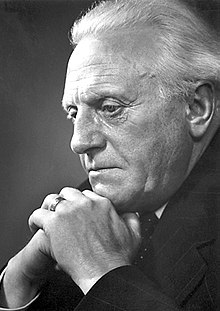Par Lagerkvist
Pär Fabian Lagerkvist (born May 23, 1891 in Växjö , † July 11, 1974 in Danderyd near Stockholm ) was a Swedish writer and poet. In 1951 he received the Nobel Prize in Literature .
Life
Lagerkvist was born in Småland , the youngest of seven sons of a railroad man . Mentally shaped by a deeply religious family, he decided at a young age to become a writer. From 1910 to 1912 he studied art history and literature at Uppsala University .
In 1913 he went to Paris for a year , where he studied art and became a fan of Cubism and Expressionism .
During the First World War , Lagerkvist lived in Copenhagen , where he wrote the volume of poems Ångest (fear) and his first plays. It was there that he met Karen Sørensen, whom he married in 1918. In 1925 the marriage was divorced again and Lagerkvist married the widow of the painter Gösta Sandels, Elaine Luella Hallberg. From this marriage the twin sons Bengt Anders Lagerkvist and Ulf Gudmund Lagerkvist and the daughter Elin Lagerkvist emerged.
In 1930 Lagerkvist largely withdrew from the public eye and lived with his family on an island in the municipality of Lidingö .
Lagerkvist had been a member of the Swedish Academy since 1940 .
Artistic creation
Lagerkvist began to publish poems in the local press as a schoolboy. He published his first collection of short stories, Männniskor , in 1912. His novel Dvärgen (The Dwarf, 1944), an instructive story about evil, brought him international fame for the first time. His last book, the dramatic love story Mariamne (Herod and Mariamne), was published in 1967.
One focus of his works is the conflict between good and evil, which he depicts with figures such as that of a medieval executioner, the god-doubting Barabbas , or the restless Jew Ahasuerus . As a declared moralist, Lagerkvist used religious motifs and figures from the Christian tradition, but without following the doctrines of the church.
Lagerkvist's best-known novel, “ Barabbas ” (1950), was praised as a masterpiece shortly after its publication, among others by the Nobel Prize winner André Gide . The novel is based on a biblical story. When the people of Judea granted the condemned Barabbas a pardon - and not Jesus of Nazareth - the thief and murderer tried to understand the deeper meaning of this decision and, in the course of his life, went from seeker to god-finder, from doubter to believer. The novel was made into a film in 1953 and 1961 (see Barabbas (1953) and Barabbas (1961) ).
Awards and honors
- 1941 Honorary doctorate from Gothenburg University ( Göteborgs Högskola )
- 1951 Nobel Prize for Literature
- 1951 BMF badge
Works
- Ordkonst och bildkonst , 1913 (English translation: "Literary Art and Pictorial Art", 1991)
- Fear , 1916
- Guest at Reality , novel, 1925
- The executioner , narrative, 1933
- At that time , prose collection, 1935
- The dwarf , narrative, 1944
- Barabbas , Roman, 1950
- The Sibylle , Roman, 1957
- The Death of Ahasver , novel, 1961
literature
- Piotr Bukowski: Disorder - Change of Order. Pär Lagerkvist and German Expressionism. Lang, Frankfurt am Main a. a. 2000 (= texts and studies on German and Scandinavian studies; 43) ISBN 3-631-35508-4
- Agnieszka Cienkowska-Schmidt: Longing for the Holy Land. A study of Pär Lagerkvist's later prose. Lang, Frankfurt am Main 1985 (= contributions to Scandinavian studies; 4) ISBN 3-8204-8295-4
- Tobias Jäger: Olavus Petri, reformer in Sweden and other Scandinavian contributions. Verl. F. Culture u. Wiss., Bonn 1995 (= Biblia et Symbiotica; 13 u. Disputationes linguarum et cultuum orbis; Sect. V, Volkskunde und Germanistik; 3) ISBN 3-926105-54-2
- Barbara Susanne Lipman-Wulf: The dwarf figures in Par Lagerkwist's “Dvargan” and Günter Grass “The Tin Drum”. State Univ. of New York Diss., Stony Brook 1979.
- Otto Oberholzer: Par Lagerkvist. Studies of his prose and his dramas. Winter, Heidelberg 1958.
- Everett M. Ellestad: Lagerkvist and Cubism: A Study of Theory and Practice, Scandinavian Studies 45 (1/1973), pp. 38-53.
Web links
- Literature by and about Pär Lagerkvist in the catalog of the German National Library
- Information from the Nobel Foundation on the 1951 award ceremony for Pär Lagerkvist (English)
Individual evidence
- ^ Claes-Olof Olsson: Hedersdoktorer vid Göteborgs Universitet under 100 år 1907-2007
| personal data | |
|---|---|
| SURNAME | Lagerkvist, Par |
| ALTERNATIVE NAMES | Lagerkvist, Par Fabian |
| BRIEF DESCRIPTION | Swedish writer and poet |
| DATE OF BIRTH | May 23, 1891 |
| PLACE OF BIRTH | Vaxjo |
| DATE OF DEATH | July 11, 1974 |
| Place of death | Danderyd |
